Tokyo, a city famous for sushi, unique technology, street fashion, and Anime, is my favorite place in the world. There is no shortage of things to do in this wonderful city – as long as you have a thick wallet. Tokyo is the world’s most expensive city to live in, according to a recent survey by the Economist Intelligent Unit. Traveling isn’t much better, between train tickets, boutique hotels in Tokyo, food, and entry charges, it is easy to spend upwards of $200 a day, if you’re lucky.
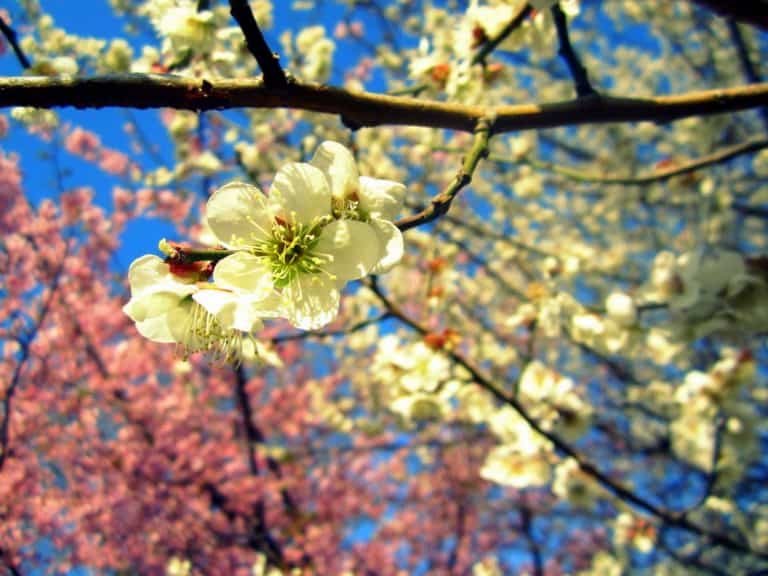
Traveling doesn’t have to be expensive as Tokyo has some hidden, cheap things to do. Avoid the “brand name” tourist traps in Tokyo, and it is feasible to spend under $25 a day (excluding hotel rooms).
Quick Navigation
ToggleWhat to Eat
Nikuman / Anman
Originally taken from China, Nikuman is a steamed bun with pork, chopped vegetables, and thick gravy on the inside. With an identical appearance, Anman has anko, or Japanese sweet red bean paste, on the inside. Some places will have especially cute Anman or Nikuman buns.
Rotator-belt sushi
Skip the expensive sushi that can cost upwards of 5000 yen per person. In Tokyo, there are plenty of 100 yen or 105 yen rotation sushi joint. These rotation sushi restaurants, called kaitenzushi, are scattered throughout Tokyo, even in high-end districts. Seated on a bar stool or booth, you get firsthand access to fresh sushi, whizzing by on a conveyer belt.
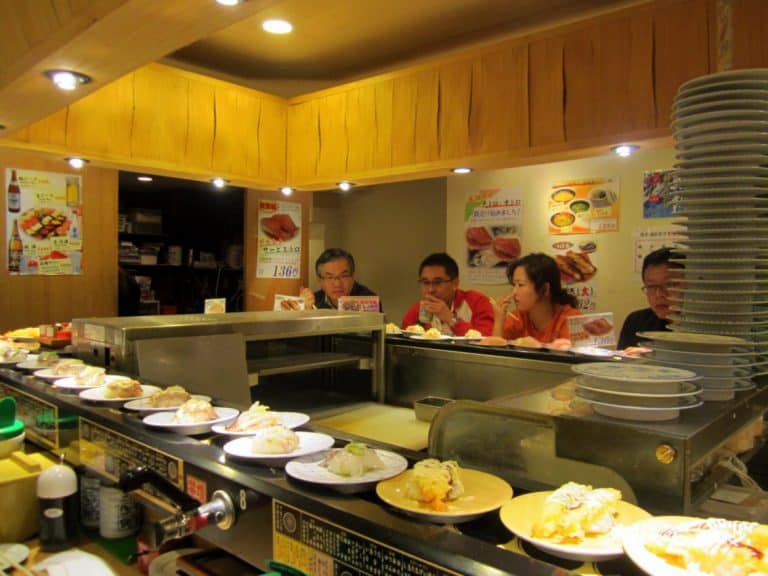
Gyudon
Gyudon, also known as beef bowl, is a traditional Japanese fast food specialty. With a variety of brands, such as Matsuya, Sykiya, and Yoshinoya, you can get a complete meal of beef, pork, or curry with onions, leeks, and red pickled ginger for 380 yen to 450 yen.

Convenience store Onigiri, corndogs, and Nikuman
As a place to pay your utility bills, pick up the latest weekly magazine, and grab a snack, convenience stores are the best place to grab a meal for under 500 yen. Some of the best things to try:
Onigiri
it’s a triangular ball of rice with a special filling on the inside, surrounded by fresh, toasted seaweed. Popular filings include fish eggs, salmon, konbu seaweed, pickled ume plum, and tuna and mayonnaise. Most Onigiri are sold with a layer of plastic separating the rice and seaweed, so the seaweed stays fresh and crunchy.
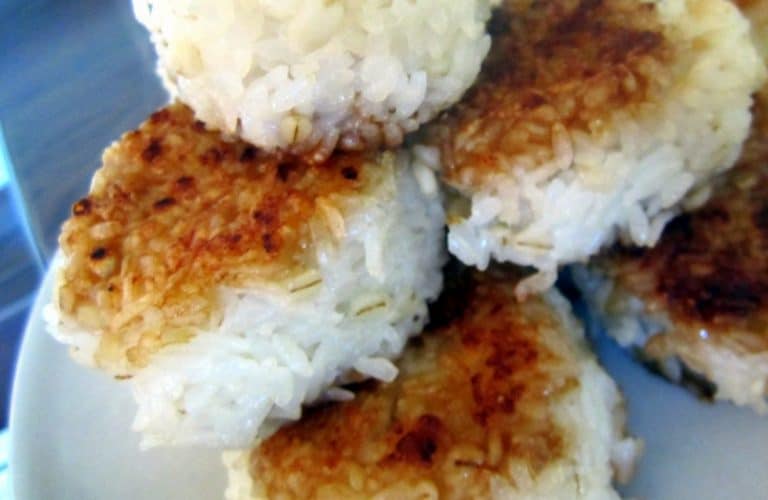
Corndogs
Corndogs, a famous American fast food, have taken a new spin in Japan. With a uniquely sugary corn dog batter surrounding a Japanese-style hot dog, corndogs in Japan taste almost dessert-like.

What to see
Pair up the spots you visit. Renting a car in Tokyo is impractical and expensive, taxis are even worse, and even something like renting a rickshaw driver can cost upwards of 4000 yen for twenty minutes. Trains and buses are the easiest way to see Tokyo, but you can easily spend over $25 a day on train tickets alone. Instead, buy a single ticket from your hostel to a specific spot in Tokyo, and then spend the rest of the day exploring the area on foot. Don’t forget to pack comfortable walking shoes.

Some example day tours are:
Shibuya Station
Shibuya is the pop culture center of Tokyo. From the Hachiko exit of Shibuya station, check out the historically preserved train car dedicated to Hachiko, the Akita dog that waited for his master every afternoon at the train station, after his master suddenly died at work and never came home. Across the street from the Hachiko statue is Shibuya crossing, the busiest intersection in Tokyo. Down the road is Shibuya 109, the 13 floor, cylindrical shopping center. Hailed as the most famous shopping center in Tokyo, the small boutiques in Shibuya 109 are always crowded.

Akihabara Station
Akihabara is considered the “nerd” capital of Japan. In Akihabara, you can buy all sorts of Anime paraphernalia, cheap electronics, and sex toys. Avoid the themed cafés in Akihabara, especially the famous maid cafés – where the cover charge to sit down is usually 1000 yen or more. Go to the enormous Donki Hote store, a seven floor chain shop with a variety of apparel, food, and weird Japanese toys. Grab a cup of coffee at the AKB48.

Themed café (named after AKB48, a famous girl group with 48 attractive members) and Gundam café (a themed café based on the Gundam anime).
Harajuku station
Meji Shrine, one of the largest shrines in Japan, is adjacent to Harajuku station. At Meji Shrine you can get your fortune told for 100 yen. Next, move to Yoyogi park (5 min walk), an enormous park famous for their free shows; every Sunday artists, musicians, dancers, and ventriloquists gather in this park, performing all day long. After that, walk through Harajuku, an area in Tokyo wildly famous for their “unique” street style. On weekends, teenage girls, young adults, and old ladies will dress up in exotic styles, often wearing colorful wigs, gothic Lolita style dresses, and heavy makeup and stroll around Harajuku.
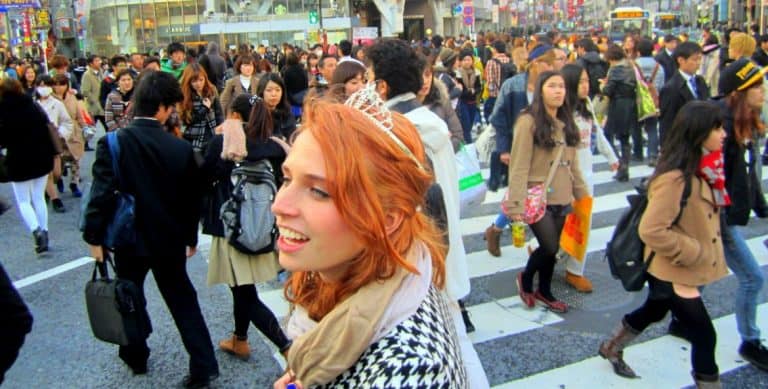
Asakusa Station
Asakusa is one of the best places in Tokyo for tourists. The Nakamise dori road that leads up to gorgeous Sensoji Temple sells a variety of souvenirs, traditional Japanese snacks, chopsticks, fans, and traditional clothing. The Sensoji Temple is a wonderful, looming temple, famous for the vivid red walling. Festivals are held in Asakusa year round; surrounding Sensoji temple are other, smaller temples. From the observation deck of the Asakusa tourist center, you can get some great pictures of the new Tokyo Skytree.
What to do
Go to day-time Karaoke
Karaoke is famous throughout the world. With thousands of songs from Japanese, Korean, Chinese, American, and other foreign artists, it is easy to spend several hours belting your heart out in the microphone. Each room is personal; rates are charged based on the number of people and the time of day. The weekday day rate is cheap; after 5pm or on weekends the rates double or triple.
Take Purikura
Purikura, roughly translating to “Sticker picture,” are fun photo booths in Japan. Purikura booths exaggerate your features, giving foreigners abnormally large eyes. Once the pictures are taken, you can decorate them with an electric pen. The pictures are printed on sticker photo paper; groups of friends cut up and distribute the pictures, affixing the stickers to their cell phones, laptops, and notebooks. Purikura costs 400 yen.

Tour Ebisu Beer factory
Ebisu, a district in Tokyo named after Ebisu beer, has a quaint beer factory museum in the center. For 500 yen a person, you can get a fun tour and two complementary glasses of Ebisu beer (one dark, one light). After the tour, you can stay in the Ebisu beer factory tasting room, drinking heavily discounted beer until the museum closes.


Grace Buchele Mineta is an American engaged to a Japanese businessman, living in Tokyo. As a part-time blogger and full-time student, she enjoys backpacking throughout Japan, writing about Tokyo, and learning the sophisticated styles of Japanese cooking.

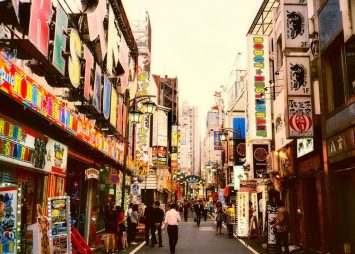
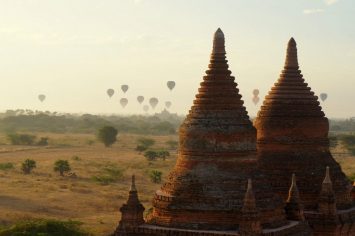
32 thoughts on “How to Travel in Tokyo for Less Than $25”
Hey Ageness thanks for sharing such an intelligent idea to enjoy in such an expensive city. Actually every place have expensive and cheap places because both rich and poor peoples lives all around the world. So we have to just find them smartly and intelligently. :) :)
Thanks a lot for the kind words. Really appreciate it! This posts prove that everything is possible and you can enjoy any travel destination on the cheap if you want to. Glad you enjoyed reading it!
Great post! I went to Tokyo 2 summers ago very much on a budget, and was amazed at how many affordable things there were to do! A lot of the parks/temples/gardens are free or very inexpensive, the ramen houses are a steal, and at night there were those “all you can drink” places for a set amount of yen if you felt like getting really crazy!;-)
Jess, that’s true. Japan offers a lot of free activities and although this country is considered as one of the most expensive in the world, we (budget travelers) can still make it cheap or at least affordable! I can’t wait to visit some Japanese temples and parks. Love watching cherry blossoms!
Love this. Having been to Japan years ago, I’ve been itching to go back. The prices scare me a little bit! This is excellent advice. I especially love the point about buying a ticket to a specific area in Tokyo and then exploring on foot. From my experience, exploring on foot is better for stumbling upon cool areas you’d have never seen otherwise.
Emily, thanks for sharing. Yes, the prices can be a bit scary, especially when you think of how cheap other Asian cities are. I would also love to explore some beautiful and interesting Japanese cities on foot or go cycling!
We just got back from Tokyo and definitely spent more than $25 per day. It can be such an expensive city, but I love it so much! I’ve been to visit four times!!! Asakusa and Harajuku are two of my favorite areas. I haven’t heard of that beer factory so will have to check that out next time! :-)
Yes, it’s hard to stick to your budget when you are in Tokyo. Four times? Insane! I will add Asakusa and Harajuku to my list!! :)
I LOVE sushi and would love the conveyer belt sushi places- just grab what I want. As a matter of fact- that’s what I had for lunch today- only the old-fashioned way- delivered by a human.
Welcome to sushi lover club! Although I am sometimes so bored with the rice, I could eat sushi all the time! Yum!
I love onigiri so much, they are very simple food but so tasty! I’ve even learnt how to make them (it’s no that difficult at all). Yum Yum!
Never tried them, but I’ve heard it’s a very delicious meal. Might try to make it at home :)
I’m definitely saving this, my husband Gray is obsessed with Tokyo since visiting years ago. I haven’t been yet but it’s somewhere I’ve got to get to one day (especially after hearing so much about it)!
I also can’t wait to finally visit Japan. Cez’s going for a cycling adventure there next month. I’m so jealous when I see him make the whole plan!!
One of the places will die to go to, amazing culture and beautiful country. Loved the tips and great photos.
Couldn’t agree more. Thanks!
I can’t believe how many good ideas there are in here to make one’s dollar go just a little further. I have yet to visit Japan. I’m glad to see there are travelers visiting the country, and still able to do it cheaply. A very informative post.
Where there is a will, there is a way Leigh! I didn’t know myself that you can do Japan for less than $25. Love the idea!
These are all great ideas, and I’d add that Tokyo has many great parks and even a few temples that are free or very cheap to visit as well. I know most people don’t go to Tokyo for historical or outdoor attractions, but they’re great places to watch modern Japanese people go about their daily lives!
One thing I noticed that is missing from this article but that is pretty critical is somewhere to stay. The reality is that unless you CouchSurf, I don’t think it truly is possible to do Tokyo for less than $25/day. My husband and I stayed in an 8-bed dorm in the Asakusa area and that was costing us $35/per person per night, which already blows your daily budget. Even capsule hotels were not really any cheaper, especially if you are traveling as a couple. Unfortunately, accommodation is likely what will break your budget again and again in Japan, though these tips can certainly help you save money on other categories.
I know, the accommodation is a real pain in Japan. Cez is going to Japan next month and he’s going to cycle every day from one destination to another. In order to do it on the cheap (under $25) he bought a tent where he is going to sleep. Pretty wild, but it’s another way of saving the money :)
Yes, you can manage to enjoy Tokyo for around 25$ a day but it’s hard….As someone else mentioned, accommodation can blow up your budget and Japanese are not very likely to open their shoe-box sizes apartment to foreigners…I was lucky that I have a friend in Tokyo and stayed with her for 2 months. Otherwise, my budget would had been 250$ a day :P just kidding
About accommodation, another cheap idea, maybe not the most comfortable one but it is more spacious than capsule hotel is the manga kissa, the cubicles used for the manga freak to read. Some of them have a comfortable chair similar to an air mattress, TV, playstation and free drinks from the machine (even corn and potato soup, I survived a few days on that. You can rent them per hours so it’s cheaper.
Eating in local eateries or just grabbing a snack should put your budget a little bit down. Also the izakayas are not so expensive, if you have someone local to help you to order.
Entry to museums, castles and Japanese gardens tends to be free or quite cheap.
For transport I was using the same advice mentioned above, just spend the day exploring by foot, borrowing bikes…hitchhiking worked surprisingly good for me to travel around Japan (You remember my post about that?) so I will recommend to do it there, people are extremely nice.
I am positively envious that Cez is going to Japan by bike!!! :D
Noelia, my little angel, you are a star. Many thanks for the comment. It’s just lovely!! x So many valuable information here. Cez has already bought his bike and he’s getting so excited. He’s taking a tent with him not to spend too much money on the accommodation :-D :-D!!
My first reaction after reading the title was, No Way! Because budget must be the only let down for anyone to take a holiday in Tokyo. However, these are some great ways to save.
Impossible in nothing … :-)
Inspiring post, Agness! I don’t think I could stomach a sweet corn dog but I’d love to pose for some sticker photos. Tokyo looks like great fun.
mmmmm convenience store sushi
We certainly did blow the bank in Tokyo. So glad to see that others might be able to come out of there less scathed. We visited most of the sights you recommend, but definitely added a “0” to your budget. A true public service, this blog is.
Great tips! I’ve been reading a lot about Japan recently and it’s making me want to go even more badly! Oddly enough, sushi is one of the cheapest foods I’ve found in Sydney since I moved her a month ago. I bet it’s better in Tokyo though!
I would love to visit Tokyo. Those sticker photos look like so much fun! :-)
Hello there nice article. I’ll go to Japan next month by budget travelling and i found your article quite help me to go travelling across Japan. Wish me luck because this is my first trip :D
O yeah, any recommendation sushi place in Tokyo??
I love your post :) I will keep that in mind if I have a chance to go :)
It also reminded me that few years ago my husband went to Japan, with a friend they got that unlimited train pass (I don’t know if it’s still there and how much it costs now) so instead of going to a city for 2 days, they took a train early in the morning, come back with the last one possible to save the hotel fee. two days in the row. and somehow he’s still proud of ‘I’m so cheap it makes me a genius’ … ;)
Thanks a lot!!